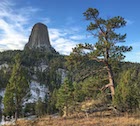
Nearly pure forest of P. scopulorum (with minor Juniperus scopulorum) at Devil's Tower National Monument, Wyoming [C.J. Earle, 2019.10.14].
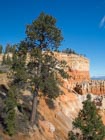
Mature tree growing on the rim at Bryce Canyon National Park, Utah [C.J. Earle, 2015.11.20].
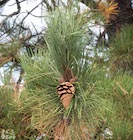
First- and second-year cones and foliage on a tree growing above the Yellowstone River near Columbus, Montana; note the many 2-needled fascicles and the relatively short, wide cone [C.J. Earle, 2019.09.27].
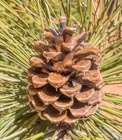
Cone in situ, Bryce Canyon National Park, Utah. The relatively short, fat cone and the presence of 2-needle fascicles mark this as a specimen of P. scopulorum [C.J. Earle, 2015.11.21].
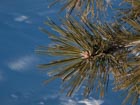
Foliar unit on a tree with relatively short, stout needles; Bryce Canyon National Park, Utah [C.J. Earle, 2013.12.06].
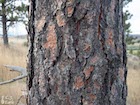
Bark on a mature tree growing above the Yellowstone River near Columbus, Montana [C.J. Earle, 2019.09.27].
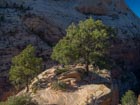
Old trees growing on bare sandstone at Angels Landing, Zion National Park, Utah [C.J. Earle, 2015.11.22].

Slow-growing Pinus ponderosa and P. longaeva rooted in a dolomite-rich fascies of the terrigenous Claron Formation, Bryce Canyon National Park, Utah [C.J. Earle, 2016.05.06].

Tree growing on the rim at Bryce Canyon National Park, Utah. The area is heavily used by visitors, which has likely contributed to ongoing erosion that has exposed much of the root system and likely retarded the tree's growth [C.J. Earle, 2015.11.20].

Strip-bark tree ca. 1 m tall growing on sandstone (and nothing else), Zion National Park, Utah [C.J. Earle, 2013.12.06].

Pinus scopulorum
(Engelm.) Lemmon 1897
Common names
Rocky Mountain yellow pine (Peattie 1950), Rocky Mountain ponderosa pine (Kral 1993).
Taxonomic notes
Synonyms:
- P. ponderosa Dougl. ex Laws. var. scopulorum Engelm. ex S. Watson 1879;
- P. ponderosa Dougl. ex Laws. subsp. scopulorum (Engelm.) A.E. Murray 1982;
- P. ponderosa Dougl. ex Laws. subsp. scopulorum (Engelm.) W.A. Weber 1982;
- P. ponderosa Dougl. ex Laws. subsp. readiana (Engelm.) Callaham 2013.
Callaham (2013), in the most detailed work yet presented on the morphology of the taxa commonly called "ponderosa pine", divided them into 5 subspecies, two of which, readiana and scopulorum, are here reduced to synonymy within a single species, Pinus scopulorum. That hierarchy is based primarily upon molecular evidence; for detail, see the "Taxonomic notes" for Pinus ponderosa. Within the group of subsection Ponderosae occurring in the U.S. east of the range of P. ponderosa, relationships remain unclear at this time, partly due to sampling limitations but more importantly because there are important patterns of genetic variation that do not coincide, such that each population is in some degree distinct and unique. The question is, can that situation be captured with reference to existing described taxa, or must new taxa be introduced?
Molecular data show that P. ponderosa is polyphyletic with regard to the eastern taxa, thus I have chosen to segregate them in different species while retaining as much of P. ponderosa as constitutes a monophyletic group. The eastern taxa include a taxon of the northern Rockies described by Lemmon as Pinus scopulorum, a taxon of the high plains described by Callaham as Pinus ponderosa subsp. readiana, a taxon of the southern Rockies and extending west into Nevada that also seems to fit well with Pinus scopulorum but has important diffences in mitochondrial haplotypes, and a taxon found from eastern Nevada into southern Arizona that fits with Pinus brachyptera as described by Engelmann. From southern Arizona east to the Chisos Mountains of Texas, and south far into Mexico, there are other taxa of subsection Ponderosae that clearly bear some molecular and morphological similarity to the U.S. species, but relationships are very unclear and much additional sampling will be needed to elucidate them. Of the above-named taxa, I note that subsp. readiana in the central high plains is marginally distinct from P. scopulorum and is also not confirmed by molecular data; I also doubt it on biogeographic grounds, given the rapid early-Holocene migrations in subsp. scopulorum (again, see the P. ponderosa discussion). It seems rather to be an ecotype of P. scopulorum; accordingly I have reduced it to synonymy with that species. There are likely some infraspecific differences between the northern and southern populations of P. scopulorum, but they have not yet been described as distinct infraspecific taxa, and in any event it is not clear that there are measurable, consistent morphological differences. There are, however, measurable and consistent differences between P. scopulorum and P. brachyptera, so the latter is retained at species rank.
Molecular clock analyses (Lascoux et al. 2004, cited by Potter et al. 2013) suggest that the separation between P. ponderosa and P. scopulorum occurred more than 250,000 years ago, and the division may have persisted since the onset of glacial/interglacial cycles at the Pliocene/Pleistocene boundary, or even earlier, with separation happening when tectonism created the Basin and Range structure of central Nevada in an area that formerly was montane plateau (see discussion by Potter et al. 2013).
There is likely to be some popular frustration over the renaming of such an iconic species. Lemmon (1897) addressed this issue when he described Pinus scopulorum, saying "Several so-called marked varieties of our western conifers, I am convinced, are entitled to take rank as species. Crowding two or more marked forms into one polymorphous group, while it emphasizes the fact that they are related, gives us little other knowledge of them. We know in this age of the world that all groups of plants are connected, more or less closely, and we believe that they are all derived from a few simple, primordial forms. As we meet with the termini of these lines of development we find them greatly diversified while also retaining vestiges of kinship. We advance knowledge of these lines — these genera and species — more by detecting and separating than by ignoring and generalizing."
Description
Monoecious evergreen trees to heights of 24 (-49) m and DBH 100 (-164) cm. Stem usually straight and robust; branches thick and persistent; usually one whorl per year; usually 1 to 5 branches in a whorl, the branches inserted at a 36°-50° angle from apex of the stem of young trees. Bark on mature trees vertically fissured, dark brown or dark gray to black; on old trees becoming cinnamon-red, thick, with broad plates separated by shallow fissures. Xylem oleoresin odor (discernible in bark crevices warmed by the sun), usually smells like turpentine. Needles finely serrate, acute, finely lined with stomata on all faces, 9-18 cm long and green to blue-green, paler and shorter at higher elevations and under xeric conditions; generally not glaucous, but becoming glaucous at higher elevations and with the onset of winter; notably stiff, and in fascicles of 2-3; remaining green on stem an average of 3.6-7.9 years, longer at higher elevations; persisting on branch only a few years, giving a tufted appearance to branches, but extending farther along the branch, giving a foxtail appearance, at higher elevations; enclosed at the base by sheaths of papery bracts that are, in the first year, 10-15% of needle length but that weather away to leave a thick, dark brown to black sheath 4-8 mm long. Vegetative shoots elongating only once each year; in the current year, brown or with white to gray waxy bloom. Vegetative buds covered with ovate acute scales that are conspicuously fringed with fairly short, brownish hairlike projections; scales closely appressed, light chestnut-brown or gray brown, dotted with resin during summer, sometimes covered with resin during winter. Pollen cones borne in clusters of 5-30, long-cylindrical, 10-50 mm long, dark red to purple. Seed cones in first year 15-25 mm long, on stalks half as long; red on emergence, turning greenish brown, with short, appressed, mucronate scales, prickles usually erect; symmetrical and straight to slightly curved, averaging 71 mm long, ovoid or globose; color during second summer tan to reddish or chocolate brown; subsessile and deciduous during the first winter after ripening, very short stalk and a few basal scales usually persisting temporarily on branch after the cone falls. Seed cone scales 112-141, narrow, slightly concave, usually rounded at apex; apophysis yellow to brown, lustrous, only slightly elevated along a transverse keel; umbo salient and forming base of a stout, persistent prickle usually directed outward, but occasionally slightly reflexed; adaxial surface slightly concave and dull tawny to red brown; abaxial surface dark brown, purplish, or blackish. Seeds dark brown or speckled; ovoid acute; 5-8 mm long with a width-length form factor of about 2/3. Seed wings thin, semitransparent, pale brown, sometimes darkly streaked with brown; widest at or slightly below midpoint; gradually narrowed to rounded apex; 3.3-4.3 times as long as the seed; average length 16.25 mm (Callaham 2013).
See P. ponderosa for a table detailing differences from the other taxa commonly called "ponderosa pine".
Distribution and Ecology
USA: Montana, North Dakota, South Dakota, Wyoming, Utah, E Nevada, Colorado, Nebraska, Oklahoma. New Mexico and Arizona; Mexico: N Sonora. Mostly at 1000-3000 m elevation (Kral 1993).
Molecular studies (summarized by Willyard et al. 2021a, 2021b) indicate a fairly extensive area where P. scopulorum and P. brachyptera co-occur. In general, herbarium specimens assign collections to these taxa with indifferent accuracy, and so there is currently low confidence regarding the range limits of each species within the area that, in general, includes eastern Nevada, all of Utah, and southwestern Colorado. It is likely that some hybridization occurs as well, although its extent is not well understood.
Distribution data. Colored polygons showing species distribution from USGS (1999). Point data representing my personal observations and published herbarium data. My observations are dated, precisely located, and include a listing of associated tree species ranked in descending order of dominance. Published herbarium data are extracted from the GBIF database and are of variable reliability. I have allocated the colors on the basis of available information: P. ponderosa subsp. ponderosa shown in red, P. ponderosa subsp. benthamiana in green, P. ponderosa subsp. washoensis shown in tan, and P. brachyptera and P. scopulorum in blue (see those taxa for discussion of the complexity in differentiating their ranges).
The IUCN does not recognize this taxon as distinct from P. ponderosa or P. brachyptera. However, it is still probably accurate to assess P. scopulorum as "least concern" under IUCN criteria due to its extensive area of occupancy and the limited scope of its threats.
Remarkable Specimens
The largest on record has diameter 164 cm, height 41.5 m, and grows in Lee Canyon in the Spring Mountains of southern Nevada (Robert Van Pelt e-mail 2004.02.04; note that this might be a specimen of P. brachyptera). The tallest tree is in the Dutch Creek drainage, San Juan Mountains, Colorado, and stood 49.5 m tall with a dbh of 83 cm when discovered and measured on 2014.08.03 (Markworth 2014; note that this also might be a specimen of P. brachyptera). Another very tall tree, also in the San Juans, was measured by Bob Leverett in 2009 at 48.98 m tall and 86.6 cm dbh (Robert Van Pelt e-mail 2009.06.22; again, might be a specimen of P. brachyptera). Another very large/tall tree is about 20 miles southeast of Pagosa Springs, Colorado: 43.9 m tall and 145 cm DBH in 2003 (Robert Van Pelt e-mail 2007.10.23; also might be a specimen of P. brachyptera).
The oldest recorded was a tree collected in the Wah Wah Mountains of Utah by S. Kitchen, that had a crossdated age of 929 years (RMTRR 2006; this could be a specimen of P. brachyptera). Also, a crossdated age of 843 years for specimen BRY4002, collected in central UT by Schulman in 1956 (Brown 1996; also might be a specimen of P. brachyptera). There is also an old but credible record of a ring count of 1,047 from a tree in southwestern Colorado (Mills 1914; also might be a specimen of P. brachyptera).
Ethnobotany
Within its range, this is an economically important timber species. Common current uses include structural lumber, lumber for furniture and finish carpentry, firewood, and log cabin construction. Under the name "ponderosa pine", it is "generally recognized as the most versatile wood found in abundance in North America" (Western Wood Products Association 2018).
Historically, the cambium would be scraped for food (often only in times of famine) by the Apache, Navajo, and Paiute tribes. Nearly everyone ate the seeds, usually roasted, sometimes ground into a flour. The pitch or sap was used by many tribes including the Cheyenne and Paiute for a wide variety of purposes including as a salve or ointment for sores, boils, cuts and earache; to reduce inflammation of the eyes; to treat backache or rheumatism; and to pacify babies by spreading it on their skin. Decoctions of green leaves were put to similar uses. Many tribes used the pitch as a glue or sealer; the Cheyenne used it to tune flutes and whistles. The wood was widely used in structures, to make dugout canoes, and for other uses such as cradle boards, ladders, and of course firewood (University of Michigan Ethnobotany Database 2013.09.07).
Observations
In my experience, dense and continuous stands may be seen in the Black Hills of South Dakota, so named for the dense stands of ponderosa covering their slopes. Exceptionally old and picturesque trees may be found throughout the deserts of southeast Utah, particularly on the lower slopes of the Abajo and La Sal Mountains; and at Vedauwoo in southeast Wyoming. Other noteworthy occurrences include: (a) the Malpais Lava Beds National Monument of New Mexico, where some of the oldest known trees are found and (b) the plateaus of northern Arizona and New Mexico, where pine forests that were used in building the Anasazi civilization 900 years ago.
Remarks
Engelmann (1897) named this "Rocky Mountain pine", and Callaham (2013) notes that the Latin noun scopulus means rock, ledge, shelf, or cliff, thus, Pinus scopulorum is the "pine of the Rockies". The same rationale applies to Juniperus scopulorum.
This species is a principal host for the dwarf mistletoe Arceuthobium vaginatum subsp. cryptopodum (Hawksworth and Wiens 1996).
Perhaps no other tree is as emblematic of the American west. One can seldom travel far in the West without seeing a ponderosa pine. It built settlers' cabins and furniture, fueled steam locomotives, timbered mines, and fed sawmills throughout the rise of this country. Even today its management is the first concern of forest managers across much of the West, and endless studies have been published on the species' fire ecology, its response to climate change, its vulnerability to diseases, the ecological functions of every life history stage from seedlings to old growth, and countless other attributes of the species' biology.
Citations
Callaham, Robert Z. 2013. Pinus ponderosa: A taxonomic review with five subspecies in the United States. Research Paper PSW-RP-264. Albany, CA: USDA Forest Service Pacific Southwest Research Station. 52p.
Lemmon, J.G. 1897. Three west-American conifers. Garden and Forest 10:183. Available at the Biodiversity Heritage Library, accessed 2021.11.26.
Markworth, Matt. 2014.08.14. Hermosa Creek - Tall Rocky Mountain Ponderosa Pine. www.ents-bbs.org/viewtopic.php?f=70&t=6495&sid=8af5a9126e89fa3e988e8a2ecabd370b#p29581, accessed 2014.08.17.
Mills, Enos A. 1914. The story of a thousand year pine. Houghton Mifflin Co. Boston, MA. The story can be found online (bless those copyright expiration laws!) HERE.
Murray, E. 1982. Notae Spermatophytae No. 1. Unum minutum monographum generis Pinus. Kalmia 12:18-27.
Willyard, Ann, David S. Gernandt, Blake Cooper, Connor Douglas, Kristen Finch, Hassan Karemera, Erik Lindberg, Stephen K. Langer, Julia Lefler, Paula Marquardt, Dakota L. Pouncey, and Frank Telewski. 2021a. Phylogenomics in the hard pines (Pinus subsection Ponderosae; Pinaceae) confirms paraphyly in Pinus ponderosa, and places Pinus jeffreyi with the California big cone pines. Systematic Botany 46:538–561.
Willyard, A., Gernandt, D.S., López-Reyes, A., and Potter, K.M. 2021b. Mitochondrial phylogeography of the ponderosa pines: widespread gene capture, interspecific sharing, and two unique lineages. Tree Genetics & Genomes 17(6):47. doi:10.1007/s11295-021-01529-4.
Thanks to M.P. Frankis for his assistance with the Taxomonic Notes for this taxon.
See also
FEIS database.
Friederici, Peter (ed.). 2005. Ecological Restoration of Southwestern Ponderosa Pine Forests. Washington, DC: Island Press.










